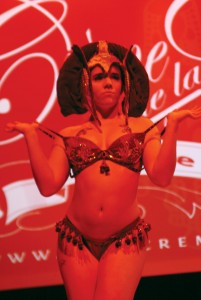Burlesque first gained prominence in repressed Victorian England. In America, burlesque’s heyday lasted from the 1920s to the ’40s. The shows were more comedy than sex, but that didn’t stop defenders of decency from decrying it as immoral. A New York City district attorney blamed the popularity of the dancers for all of the sex crimes in the county.

The term “burlesque” wasn’t just limited to musicals. It was applied to all sorts of comic plays. Beginning in the 1840s, the shows appealed to the lower and middle classes in England and the United States by making fun of (or “burlesquing”) the operas, plays, and social habits of the upper classes. Burlesque productions were among Broadway’s biggest hits of the mid-19th century.
By the 1860s, British burlesque used shapely underdressed women to keep audiences interested. In the Victorian age, when proper women went to great lengths to hide their physical forms beneath corsets, the idea of young ladies appearing onstage in their skivvies would have been scandalous.
The striptease wasn’t introduced into burlesque until the 1920s. It was a desperate bid to offer something that vaudeville, film, and radio could not. Starting in the 1960s, the artform evolved into, basically, softcore porn, but its revival began in the retro-obsessed mid-1990s. Traveling shows popped up in New York City and Los Angeles before migrating toward the middle of the country.
Famed Broadway producer Billy Rose, who built the original Casa Mañana as an outdoor amphitheater and restaurant, brought burlesque to local audiences in the 1930s via The Billy Rose Beauties. A dancer named Tammi True, a.k.a. Miss Excitement, sued a Jacksboro Highway club owner who allegedly switched off her spotlight to allow patrons to pinch her. The case never went to trial, but the publicity caught the attention of Dallas club owner Jack Ruby, who hired Miss Excitement to work at his place.
There was a huge difference between a Casa show and one at, say, The Skyline Ballroom on Jacksboro. The Casa dancers were scantily clad. The Skyline’s were totally nude. Admission to the Casa shows was 15 cents, a nickel more than its seedier counterpart.
Eventually, the classier form of burlesque dropped off the map completely, while the sort of show you would have seen on Jacksboro transformed into what we now witness at strip clubs.
*******












Really impressed by what Creme de la Creme is doing!!!! In case anyone is curious, the mysteriously anonymous burlesque program mentioned a few times in this piece is The Burlesque Experience. In its 17th season, the program has successfully and joyfully brought nearly 200 DFW women to the stage! http://www.theburlesqueexperience.com
Happy to be affiliated with these amazing performers! Congratulations, ladies! You’re lighting up Ft Worth in a stunning way!
So the minute Ms. Reaves leaves, the puerile and fatuous Mr. Griffey loads up that stripper story he’s wanted to do for ten years. Giggling as he types. At least you could have worked in some fracking into the story (like Blaze doing interpretive dance of a gas well on fire).
Thanks, Dan. Talk about puerile and fatuous – former staffer making up a sock puppet and talking shit on our website. Stay classy!
I guess maybe “sense of humor” has left the building on Hamilton Avenue these days.
You must have taken the thesaurus.
That is part of the joke. Synonyms are immamently jocose.
Great, funny writing as always Eric.